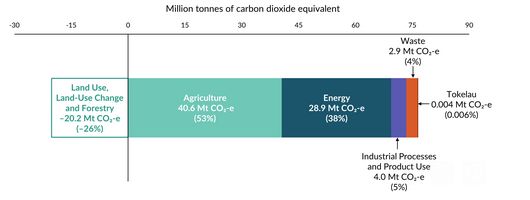Emissions Fell Across Every Sector In New Zealand In 2023
Wellington, New Zealand: Aotearoa New Zealand reduced its gross greenhouse gas emissions by 2 per cent in 2023.
That is about the same as the emissions produced by a quarter of New Zealand cars in a year.
New Zealand’s Greenhouse Gas Inventory (1990-2023), released today, shows gross emissions (total emissions other than forestry) were 76.4 million tonnes of carbon dioxide equivalent (Mt CO2-e) in 2023, 1.6 Mt CO2-e lower than in 2022.
Forests and other land uses absorbed 26 per cent of total emissions, meaning New Zealand’s net emissions dropped to 56.2 Mt CO2-e in 2023. Net emissions were 4 per cent lower than in 2022.
The Inventory is the official report of all emissions produced and removed by human activities within New Zealand, and is compiled every year by the Ministry for the Environment.
Alison Collins, departmental chief science advisor at the Ministry, said: “New Zealand’s Greenhouse Gas Inventory is like a balance sheet which provides us with data about emissions across different sectors of the economy. Access to robust evidence is vital for understanding our contribution to global climate change.
“This comprehensive record of New Zealand's emissions and removals follows internationally recognized guidelines. It provides essential insights into New Zealand's current situation and historical trends, so we can understand where our emissions come from, pinpoint areas for improvement, and make informed decisions as a country about how we address challenges and prepare for the future.”
There was a 2 per cent drop in agricultural emissions in 2023, due to reduced numbers of sheep, dairy cattle and beef cattle. Agricultural emissions have been falling since 2014, mainly because of reducing livestock populations enabled by improved productivity. Agricultural emissions are also influenced by market forces such as the price of fertiliser, and the price of emissions in New Zealand’s Emissions Trading Scheme.
Renewable electricity generation contributed to a 1 per cent fall in emissions from the energy sector in 2023. Like 2022, 2023 was a wet year that was good for hydroelectricity generation, meaning New Zealand used less coal and gas. The closure of Marsden Point also contributed, with zero emissions from petroleum refining in 2023.
There were also decreases in emissions from the industrial processes and waste sectors, and Tokelau, which reports its emissions in the Inventory. These sectors make up much smaller proportions of New Zealand’s emissions.
New Zealand’s Greenhouse Gas Inventory tracks emissions since 1990. New Zealand's gross emissions climbed in the 1990s until a peak in 2006. Since then, they have been relatively stable. Gross emissions fell in 2022 and 2023.
The Inventory covers historical emissions. Other reports provide information on progress towards emissions reduction targets. Projections released last December suggest New Zealand’s emissions will fall between now and 2050 as we continue to implement emissions reduction plans.
Breakdown of New Zealand’s emissions (in Mt CO2-e) by sector in 2023
(Net emissions from the LULUCF sector are negative because the sector removes more from the atmosphere than it emits.)

New Zealand’s gross and net emissions (in Mt CO2-e) from 1990 to 2023

Comparison between New Zealand’s population and gross emissions per capita



 Gordon Campbell: On Why The US Stands To Lose The Tariff Wars
Gordon Campbell: On Why The US Stands To Lose The Tariff Wars Community Housing Aotearoa: Ngā Wharerau o Aotearoa Says New Partnership Model Helping Ensure Right To A Decent Home Is Realised
Community Housing Aotearoa: Ngā Wharerau o Aotearoa Says New Partnership Model Helping Ensure Right To A Decent Home Is Realised Greenpeace Aotearoa: Babies At Risk Due To Nitrate-Contaminated Drinking Water In Ashburton District
Greenpeace Aotearoa: Babies At Risk Due To Nitrate-Contaminated Drinking Water In Ashburton District Driving Change Network: Response To Government’s Proposed Driver Licensing Changes
Driving Change Network: Response To Government’s Proposed Driver Licensing Changes The New Zealand Remembrance Army: Victoria Cross And Hardham Cup Come Together For First Time In Over 100-years
The New Zealand Remembrance Army: Victoria Cross And Hardham Cup Come Together For First Time In Over 100-years RNZ Online: How The World Reacted To The Demise Of The Treaty Principles Bill
RNZ Online: How The World Reacted To The Demise Of The Treaty Principles Bill Te Matapihi: Response To Govt’s New Strategic Housing Partnerships: Progress, But Equity Gaps Remain
Te Matapihi: Response To Govt’s New Strategic Housing Partnerships: Progress, But Equity Gaps Remain


